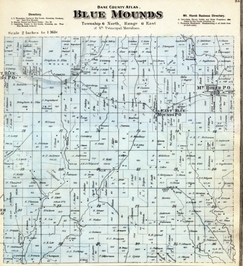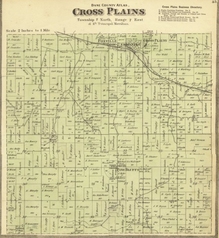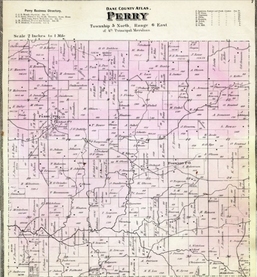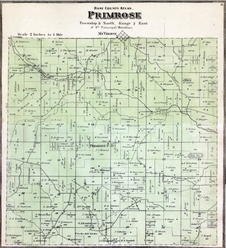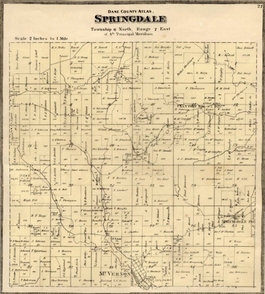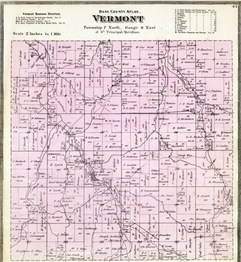Township Histories from 1873 Plat Book by Harrison & Warner
|
"The town of Blue Mounds was first settled in 1828 by Ebenezer Brigham who is said to be by four years the oldest known settler within the limits of Dane County. The organization of the town took place in April, 1848. There are five school-houses and four churches -- two Lutheran, one Presbyterian, and one Methodist congregations.
This town abounds in beautiful scenery. The Blue Mounds, the highest points in the southwestern part of the State, rise to an altitude of 1931 feet above the sea, and 1072.5 feet above the lakes in Madison. From the top of these mounds is to be seen a grand panorama. Objects many miles distant are distinctly visible, and they overlook the lead regions of Illinois, Iowa, and Wisconsin. Mineral shafts abound all about the Mounds filled with ores of lead, zinc, copper, pyrites, spars, and the ordinary varieties of matrix that inclose [sic] this class of mineral treasures. |
|
The town of Cross Plains was first settled, in 1840, by Edward Hugh and John Campbell. They were soon followed by Jno. W. Thomas, Berry Haney, Thomas Arland, and S. Bell.
It was organized, in 1847, with Ripha Warden, Supervisor; Wm. Howery, Assessor; Berry Haney, Clerk. School districts were organized the same year, and school opened soon after. In the south part of the town is an elevation called Pine Bluffs. This is a body of rock, on the top which grows a clump of pine trees. There are some high bluffs in the north part of the town near Cross Plains Village. About two-thirds of the town is productive prairie. |
|
The town of Perry was named in honor of Commodore Perry, of Lake Erie fame. It was first settled in the spring of 1846, by John Brown, a native of Indiana, who settled in Section 27. John Hobart and Anton Keller, from Germany, came in later in the year, and located in Sections 3 and 10. The next year Shute Rudy and John Sears, from Kentucky; John Eastman, from Ohio, and S.H. Campbell, settled mostly along the southern border. In February, 1848, B.F. Denson, a native of North Carolina, moved in and settled on Section 34. During this summer several Norwegians moved in, prominent among whom were Hans Johnson, on Section 20; Lars Halverson, on Section 17; T. Thompson, on Section 17, and Ole O. Bakken, on Section 4. The last named bought out a Norwegian, who had come the year before. The above-mentioned individuals may rightfully be considered the pioneers of the town, but of these only Bakken and Johnson still remain.
N.W. Denson was the first white child -- born March 19th, 1848. A daughter of John Eastman's was born April 14th, same year. The first church was built on Section 8, in 1851, belonging to the Norwegians of the Lutheran denomination. It was twenty feet square, built of logs, and is still doing service as a church, having been repaired and modified. It served as a school-house till the fall of 1852, when the first school-house was built. This was located a quarter of a mile east of where Daley's [sic] store now stands. O.B. Dailey [sic] opened the first retails store in 1853. |
|
The town of Primrose was first settled in 1845. R. Spears located on Section 19; A. Spears on Section 8; Christian Hendrixon came the next year, and settled on Section 25. The town was organized in 1849. The first officers were, David Thomas, Chairman; Samuel Nassinger and Freeman Fisher, Supervisors, and Robert Harrington, Clerk. The first school-house, called "Primrose school-house," was erected in 1847, on Section 17. G. Jackson was the first teacher. Rev. A. Price, of the Lutheran Church, was the first pastor. A mill was built in Section 7 in 1858, being the first in the town. Primrose had the honor of sending a member to the Legislature in 1868 -- Hon. G. Tullefson.
On Section 24 is a hill 200 feet high, 100 rods long, and 15 rods wide at the top, called Mt. Julia. Among the natural curiosities is the "Devil's Chimney," on Section 11. This is a solid body of rock fifty feet high, twenty-five feet diameter at the base, and fifty feet at the top. In 1850 a man by the name of Joel Britz climbed to the top, and placed a flag there. He is the first and only man that ever accomplished the feat of ascending the so-called chimney. The flag staff still stands there. Names of visitors from all parts if the United States are engraved on the rock. |
|
The town of Springdale contains some remarkable remains of the ancient people, who are supposed to have inhabited this country prior to its occupation by the Indian races -- the most noteworthy of which are to be found in Section 15. Here are three mounds, about fifty feet apart, and extending east and west. They are uniform in size, being about six feet in height above the surface of the adjacent land, and circular at the base, where they are nearly forty feet in diameter.
Commencing at the distance of fifty feet from the most eastern mound, and extending in an unvarying direction to the east, there is a long, low ridge, or bank of earth, one hundred feet in length. The height of this ridge, above the surface of the ground on which it is situated, is four feet, and measures six feet through the base, north and south; a line drawn due-east and west would divide the three mounds and ridge exactly in the centre. Being upon elevated land, the view from the site of these mounds would, were it not for the luxuriant young trees by which they are surrounded, be beautiful and commanding. In the summer of 1870 one of these mounds was partially explored by Mr. Chas. H. Lewis, a resident of the town, when a well-preserved human skeleton was unearthed, together with a stone pipe of curious workmanship, two stone knives, some highly polished and perforated pieces of bone, and many stone implements, the use of which is unknown. These mounds and their contents are objects of great interest to the antiquarian, as they point to the stone age of Wisconsin, and tend to the elucidation of the great problem in regard to that extinct and mysterious people, the mounds builders of America. |
|
The town of Vermont was named by one of the settlers, after his native State. The first settler was a German, named Joshua Harmony, who located here in 1846.
J.C. Steele, who located on Section 7, and S. Batty, on Section 6, were among the early settlers. The town was organized in 1855. The first officers were Whalon Hasbrook, Isaac C. Steele, and Jno. Caldwell. Aaron Dana, Clerk. The first sermon was preached in the year 1849, by H. Mainard, of the Methodist Church. The first school district was organized in 1859 -- Archibald Campbell the first teacher. A Catholic church was built in 1859; a Norwegian Lutheran Church in 1860. The surface of the country is very rough and hilly." |

